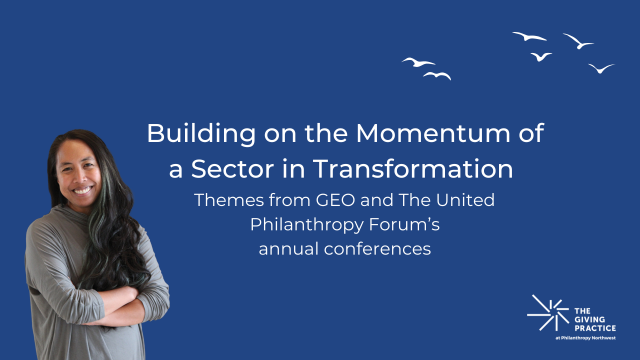
David Bley, Philanthropy Northwest Board Chair and Bill & Melinda Gates Foundation's Pacific Northwest Initiative Director
This year was a special one for all of us at the Bill & Melinda Gates Foundation. We celebrated our 15th anniversary — reflecting on a decade and a half of work with partners to improve the lives of people right here in our backyard and around the world.
While we looked back on fifteen years of progress made by our global health, development and U.S. education partners, 2015 included its own share of memorable moments for our Pacific Northwest partners and our team. Together we are helping families achieve stable housing, strengthening local community networks and supporting great schools that help students and teachers realize their potential and reach for their dreams.
Here are just a few of my favorite moments of progress over the past year.
1. Learning from hometown heroes.
Our CEO Sue Desmond-Hellmann saw firsthand how a personalized approach leads to better results in education, housing, and social services. Outcomes improve when all of the many systems that serve children and families are working together. Kids thrive when they have a stable place to call home, a good school, and a strong community that fosters a sense of belonging and opportunity.
2. Sharing powerful stories.
Storytelling can be a powerful tool in raising awareness and sparking social change. With StoryCorps and Seattle University, we partnered on “Finding Our Way,” a project that empowers people to share how homelessness impacted their lives. In May, we featured three powerful, personal stories at our Visitor Center. These stories — now posted on Firesteel’s website — highlight personal experiences of homelessness and housing insecurity in profound ways.
3. Celebrating progress in education.
We brought together education leaders from around the country for the foundation’s first U.S. Education Learning Forum, gathering to discuss lessons learned and efforts to improve opportunities and outcomes for all our kids — from preschool through college. We heard from teachers, students, parents and advocates who shared their experiences, their strategies to improve education, and the real progress they are driving in their schools.
4. Engaging families in student achievement.
Research tells us that strong parent and family engagement is essential for student success, but the occasional bake sale or curriculum night just isn’t enough. This year, over 50 parents, educators, and community leaders from South King County made a second trip to Harvard’s Family Engagement Institute, bringing back new ideas and a drive to involve parents in schools in deeper, more meaningful ways.
5. Expanding support for our youngest learners.
The early years are vital building blocks for a student’s success later in life. In 2015, we committed to expanding our Early Learning initiative to support high-quality pre-Kindergarten nationwide. We were also excited to see the passage of the Early Start Act, which gives more Washington State children access to quality early learning and provides resources for those in low-income families. In addition, the City of Seattle, community partners and Seattle Public Schools are collaborating to launch the voter-approved Seattle Preschool Program, which offers voluntary, high-quality, affordable preschool for all. The program met all of its first year goals for diversity, number of classrooms and enrollment. Bailey Gatzert, Van Asselt and New Van Asselt elementary schools in Central and South Seattle now offer Seattle Preschool.
6. Collaborating for student success.
We saw strong progress for students as a result of the Road Map Project, a collaborative, community-driven effort in South Seattle and South King County dedicated to equitable educational achievement. Twelve of the project’s 15 achievement indicators–-including high school graduation rates, and college completion rates-–are showing real progress for students since we started in 2010. Not only are 100% of the seven school districts in the region offering full-day kindergarten ahead of schedule, school suspensions were reduced across the board. The collaboration is inspiring all levels community support: local funders contributed $140,000 for quick-turnaround grants through the Rapid Resource Fund, and individual donors helped fund 460 classroom projects directly for teachers through DonorsChoose.org.
7. Exploring the role of race and equity in our work.
Our goal is to ensure all people have the opportunity to live healthy, productive lives. But opportunities are not equally accessible, and universal solutions may not take current or historical barriers into account. Breaking down barriers for underserved students and families is essential to our work. That’s why we engaged the National Equity Project to help us go further in our efforts — facilitating our thinking on race and equity, and its role in achieving thriving, self-determining and well-educated communities. This is just the beginning of our efforts; we’re excited to share more in 2016.
8. Connecting housing and health care.
Stable housing is critical to health and well-being. While housing and health care are currently siloed in how services are provided, they are inextricably linked in the experiences of the people we serve. This year, Melinda Gates joined us as we hosted more than 100 state and local leaders for a discussion on how to integrate and improve the delivery of both housing and health services for families recovering from homelessness — because housing is health care.
9. Supporting high standards.
Clear, consistent academic standards are working to raise student achievement and give teachers a blueprint for what students should know and be able to do at each grade level. This year, Washington students took new statewide tests aligned to our more rigorous, higher state standards — and proved they were up to the challenge byscoring higher than officials predicted and performing better than students in many other states.
10. Improving our own understanding.
We learn so much from the amazing people we work with every day — and we’re inspired by their example. People like 2015’s Washington State Teacher of the Year, Lyon Terry, who teaches 4th grade at Lawton Elementary school in Seattle. Bill Gates had the opportunity to chat with Lyon and learn from his 17-year career as an educator. One of the most important lessons Lyon teaches his students is that we often learn through mistakes and missteps, and that no matter your age or accomplishments, you can never stop learning because there is always more to learn.
Thank you for helping us learn and grow so much this year. As the year ends, and a new one begins to take shape, we’re grateful to all the people who work to provide safe, stable homes; great educational opportunities; and strong, vibrant communities for children and families. Here’s to another year of progress and opportunity.
David Bley is director of the Pacific Northwest Initiative at the Bill & Melinda Gates Foundation. This article was originally posted on The Impatient Optimists blog.


